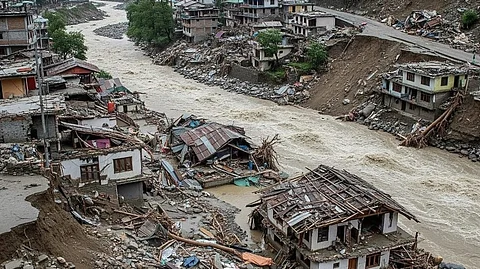
- Home
- न्यूजग्राम
- NewsGram USA
- India
- World
- Politics
- Entertainment
- Culture
- Lifestyle
- Economy
- Sports
- Sp. Coverage
- Misc.
- NewsGram Exclusive
- Jobs / Internships

A massive cloudburst struck Dharali village in Uttarkashi district on August 5, 2025.
This triggered sudden flash floods and landslides, sweeping away homes, hotels, bridges, and roads.
Four people dead and dozens feared trapped under debris as rescue operations continue.
Uttarakhand and Himachal Pradesh are reeling under the impact of relentless heavy rainfall, flash floods, landslides, and a devastating cloudburst that struck several high-altitude villages and towns. The extreme weather has caused widespread destruction—homes and bridges have been washed away, key highways remain blocked, and dozens of people are feared missing as large-scale rescue operations continue.
On August 5, 2025, a massive cloudburst occurred in the catchment area of the Kheer Ganga river near Dharali village in Uttarkashi district, triggering sudden flash floods and a deadly debris slide. The disaster tore through houses, shops, hotels, and vehicles, leaving at least four people confirmed dead. Several others, including 11 soldiers from a nearby Army camp, are still missing. Locals fear the death toll could rise as search and rescue teams continue to dig through layers of rubble and mud.
Videos from the scene showed torrents of muddy water racing down the slopes, toppling three- and four-storey buildings “like a pack of cards,” eyewitnesses said. Continuous rainfall and fresh landslides worsened the situation, washing away a bridge over the Tanglig drain and blocking the Gangotri Highway at multiple points. Dozens of hotels and homestays along the Gangotri route were destroyed, making Dharali one of the worst-hit areas.
The India Meteorological Department (IMD) defines a cloudburst as rainfall exceeding 100 millimetres an hour over an area of 20–30 sq km, usually accompanied by strong winds and lightning. Officials confirmed two separate cloudbursts—one in Dharali and another in Sukhi Top—that caused widespread devastation in the region.
Rescue operations have been launched on a war footing, with more than 200 personnel from the Indian Army, ITBP, State Disaster Response Force (SDRF), National Disaster Response Force (NDRF), police, and fire services working round the clock. Additional teams have been airlifted from Uttar Pradesh and Madhya Pradesh, while helipads in Jhala have been activated for aerial evacuations. By the morning of August 6, 70–80 people had been rescued and moved to safety. Relief camps have been set up in nearby colleges, while alerts have been issued for villages along riverbanks in Bhattwadi, Gangori, and Uttarkashi.
For the first time, the NDRF has deployed cadaver dogs to help locate bodies feared buried under debris, alongside sniffer dogs trained to detect survivors.
Prime Minister Narendra Modi, Union Home Minister Amit Shah, and Defence Minister Rajnath Singh have assured full central support to the Uttarakhand government. Chief Minister Pushkar Singh Dhami, after conducting an aerial survey, said: “All agencies are coordinating to ensure timely rescue and relief. Every possible step is being taken to save lives and assist those affected.”
Meanwhile, Himachal Pradesh has witnessed a series of rain-triggered disasters over the weekend, including 23 flash floods, 16 landslides, and 19 cloudburst incidents, leaving dozens missing and at least 78 people dead this monsoon season. Heavy downpours washed away hundreds of homes, bridges, roads, and power lines across multiple districts, cutting off towns and leaving thousands without clean water or electricity. Mandi town was among the worst affected, while treacherous terrain and continued rainfall hampered rescue efforts.
The Central Water Commission reported that several Himalayan rivers, including the Alaknanda at Rudraprayag and the Bhagirathi at Devprayag, were flowing above danger levels, raising fears of further flooding. A red alert remains in force for Uttarkashi and other districts. Schools and anganwadi centres have been shut in parts of Uttarakhand, and medical staff have been placed on emergency duty as authorities stay on 24-hour alert.
Experts warn that such extreme weather events are becoming more frequent and destructive due to the climate crisis, with unpredictable and intense monsoon rains wreaking havoc across the Himalayan region. The tragedies of Uttarakhand in 2013, Himachal Pradesh in 2023, and now this latest disaster are stark reminders of the fragile and dangerous balance between climate change and human settlement in these ecologically sensitive areas. [Rh/Eth/VP]
